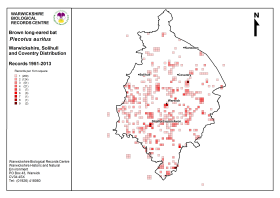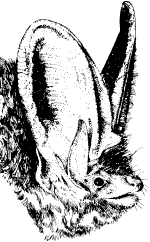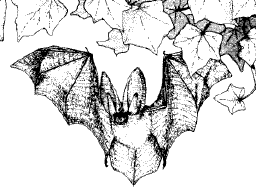Brown Long-eared

Distribution map for Brown Long Eared bats in Warwickshire. (Click for a full sized image)
 Brown
Long-eared bats (Plecotus auritus) are medium sized bats. The ears are
nearly as long as the body but are not always obvious; when at rest they curl
their ears back like rams horns, or tuck them away completely under their wings
leaving only the pointed inner lobe of the ear (the tragus) visible. It can be
very difficult to distinguish the Brown Long-eared from the rare
Grey Long-eared bat (Plecotus austriacus) of southern England.
Brown
Long-eared bats (Plecotus auritus) are medium sized bats. The ears are
nearly as long as the body but are not always obvious; when at rest they curl
their ears back like rams horns, or tuck them away completely under their wings
leaving only the pointed inner lobe of the ear (the tragus) visible. It can be
very difficult to distinguish the Brown Long-eared from the rare
Grey Long-eared bat (Plecotus austriacus) of southern England.
The Brown Long-eared bat is the second most common species in Britain and is found
throughout the UK, Ireland and the Isle of Man. It is absent from Orkney and
Shetland, and other exposed islands. It is also common and widespread in the
rest of Europe, except for southern Spain, southern Italy and Greece.
 It has declined in Britain due to changing land use, including modern intensive
agricultural practices, which have resulted in the loss of suitable feeding
habitats and hollow trees for roosting. It is particularly susceptible
to pesticides, especially their use in roofs where it often roosts on
exposed timbers.
It has declined in Britain due to changing land use, including modern intensive
agricultural practices, which have resulted in the loss of suitable feeding
habitats and hollow trees for roosting. It is particularly susceptible
to pesticides, especially their use in roofs where it often roosts on
exposed timbers.
flight & ultrasound
As well as catching insects in free flight, Long-eared bats are gleaners,
often flying slowly amongst foliage picking insects off leaves and bark. Their
broad wings and tail allow slow, highly manoeuvrable hovering flight. Sometimes
they land on the ground to catch insects or to shift them into a controllable
position in the mouth and are even able to take insects from lighted windows.
Their flight often includes steep dives and short glides.

These bats are also known as 'whispering bats' because their echolocation
sounds are very quiet. They have particularly sensitive hearing and
often locate prey from just the sound made by the insect's own movements
and not bothering to echolocate. They may also sometimes use vision. Small
prey is eaten in flight, but larger insects are taken to a 'perch'. Regularly
used perches, which are frequently inside porches or barns, can be recognised
by the accumulations of discarded insect remains, particularly the wings
of moths such as the Yellow Underwing.
 Their
habit of flying close to the ground, or even landing to tackle prey, makes
them vulnerable to attack by predators and many Long-eared bats fall victim
to domestic cats.
Their
habit of flying close to the ground, or even landing to tackle prey, makes
them vulnerable to attack by predators and many Long-eared bats fall victim
to domestic cats.
Brown Long-eared bats echolocation calls range from 25 to 50 kHz and
are best heard around 50 kHz. On a bat detector
the calls are very quiet and are heard as a series of clicks rather like
those produced by a Geiger counter.
 Brown Long-eared call on a Heterodyne bat detector
Brown Long-eared call on a Heterodyne bat detector
 Brown Long-eared call on a Time Expansion bat detector
Brown Long-eared call on a Time Expansion bat detector
breeding
 Maternity
roosts may be occupied from early April through to October or later, and
are occasionally used for the entire year. Unlike other species a significant
proportion of males may be present in maternity roosts.
Maternity
roosts may be occupied from early April through to October or later, and
are occasionally used for the entire year. Unlike other species a significant
proportion of males may be present in maternity roosts.
The female usually gives birth to its single young in late June to mid-July.
For 3 weeks the young is fed solely on its mother's milk, and is left
in a crèche inside the roost when the mother goes out to feed. Within
3 weeks the young make their first flights inside the roost and by 6 weeks
are fully weaned and able to forage for themselves. The numbers seen in
maternity roosts are usually small, although often only part of the colony
is visible.
Most females breed in their first year, but do not necessarily breed
every year. Males are sexually mature at about 15 months old.
summer roosts
 Many
roosts have been found in buildings, particularly older ones with large
open roof spaces. Bats roost singly or in small groups among the roof
timbers of the apex, especially around ridge ends and chimneys, and in
crevices in ridge tiles. The favourite roost sites are often indicated
by grease marks on the timbers.
Many
roosts have been found in buildings, particularly older ones with large
open roof spaces. Bats roost singly or in small groups among the roof
timbers of the apex, especially around ridge ends and chimneys, and in
crevices in ridge tiles. The favourite roost sites are often indicated
by grease marks on the timbers.
Long-eared bats spend more time inside the roof space than many other
bats. They may leave their roost from a variety of places and small amounts
of droppings may be evident around these points. Within the roost there
are small accumulations of droppings beneath favoured roost sites, and
a sparse scattering of droppings generally over the floor of the roof
space, particularly below the ridge. They will also roost in tree holes
and bat boxes - 65 were once found in one box!
Long-eared bats are generally very quiet inside their roost. They do
not normally leave until dark, although they are active - stretching,
grooming and flying inside the roost - for up to an hour before emergence.
When they have young to feed, females return to the roost after 1 to
2 hours to suckle them, but at other times may remain away until dawn.
The small size of maternity colonies and their frequency might suggest
that Long-eared bats have a small feeding range.
winter roosts
 Hibernation
begins in November and a variety of sites are used. Only a tiny proportion
of the Long-eared bats seen in summer are found in winter, probably because
most spend the winter in trees or tucked away in buildings, for example
in hollow walls where their presence is not obvious.
Hibernation
begins in November and a variety of sites are used. Only a tiny proportion
of the Long-eared bats seen in summer are found in winter, probably because
most spend the winter in trees or tucked away in buildings, for example
in hollow walls where their presence is not obvious.
Small numbers are found in caves, tunnels, mines and ice-houses, particularly
early in the winter and after prolonged cold spells. In these sites they
sometimes hang in the open, on the walls or from the ceiling, although
they also roost in crevices. Long-eared bats prefer to hibernate at very
cold temperatures, often just above freezing.
| Description |
|
| Head and Body Length |
37 - 48 mm |
| Forearm Length |
34 - 42 mm |
| Wingspan |
230 - 285 mm |
| Weight |
6 - 12g |
| Colour |
Adults light brown, pale underneath; juveniles greyish. |
|
|
| |
|
| Life Cycle |
|
| Mating Period |
October to April. |
| Maternity Colonies |
Established late spring.
Young: 1 born late June to mid-July, weaned at 6 weeks. |
| Colony Size |
10 to 20 (occasionally more than 50). |
| Longevity |
Up to 30 years. |
| UK Status |
Not threatened. |
|
|
| |
|
| Habitat and Food |
|
| Summer Roosts |
Older buildings, barns, churches and trees. |
| Winter Roosts |
Caves, tunnels, mines, ice-houses; probably trees and
buildings. |
| Feeding Habitat |
Open deciduous and coniferous woodland, parkland, orchards. |
| Food |
Moths, also beetles, flies, bugs earwigs and spiders.

|